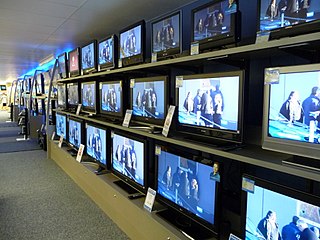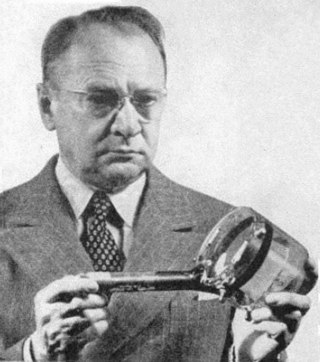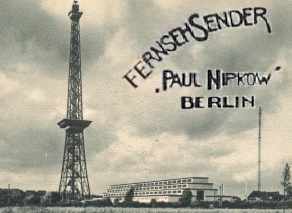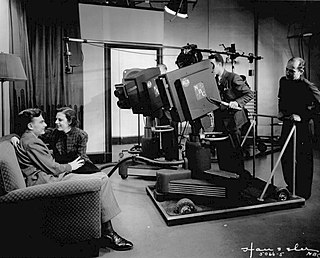
Television (TV) is a telecommunication medium for transmitting moving images and sound. Additionally, the term can refer to a physical television set rather than the medium of transmission. Television is a mass medium for advertising, entertainment, news, and sports. The medium is capable of more than "radio broadcasting," which refers to an audio signal sent to radio receivers.

A test card, also known as a test pattern or start-up/closedown test, is a television test signal, typically broadcast at times when the transmitter is active but no program is being broadcast.

A professional video camera is a high-end device for creating electronic moving images. Originally developed for use in television studios or with outside broadcast trucks, they are now also used for music videos, direct-to-video movies, corporate and educational videos, wedding videos, among other uses. Since the 2000s, most professional video cameras are digital.

Video camera tubes are devices based on the cathode-ray tube that were used in television cameras to capture television images, prior to the introduction of charge-coupled device (CCD) image sensors in the 1980s. Several different types of tubes were in use from the early 1930s, and as late as the 1990s.
Telefunken was a German radio and television producer, founded in Berlin in 1903 as a joint venture between Siemens & Halske and the Allgemeine Elektrizitäts-Gesellschaft (AEG) . Prior to World War I, the company set up the first world-wide network of communications and was the first in the world to sell electronic televisions with cathode-ray tubes, in Germany in 1934.
Walter Bruch was a German electrical engineer and pioneer of German television. He was the inventor of closed-circuit television. He invented the PAL colour television system at Telefunken in the early 1960s. In addition to his research activities Walter Bruch was an honorary lecturer at Technische Hochschule Hannover. He was awarded the Werner von Siemens Ring in 1975.

The intermediate film system was a television process in which motion picture film was processed almost immediately after it was exposed in a camera, then scanned by a television scanner, and transmitted over the air. This system was used principally in Britain and Germany where television cameras were not sensitive enough to use reflected light, but could transmit a suitable image when a bright light was shone through motion picture film directly into the camera lens. John Logie Baird began developing the process in 1932, borrowing the idea of Georg Oskar Schubert from his licensees in Germany, where it was demonstrated by Fernseh AG in 1932 and used for broadcasting in 1934. The BBC used Baird's version of the process during the first three months of its then-"high-definition" television service from November 1936 through January 1937, and German television used it during broadcasts of the 1936 Summer Olympics. In both cases, intermediate film cameras alternated with newly introduced direct television cameras.

The iconoscope was the first practical video camera tube to be used in early television cameras. The iconoscope produced a much stronger signal than earlier mechanical designs, and could be used under any well-lit conditions. This was the first fully electronic system to replace earlier cameras, which used special spotlights or spinning disks to capture light from a single very brightly lit spot.

The concept of television is the work of many individuals in the late 19th and early 20th centuries. The first practical transmissions of moving images over a radio system used mechanical rotating perforated disks to scan a scene into a time-varying signal that could be reconstructed at a receiver back into an approximation of the original image. Development of television was interrupted by the Second World War. After the end of the war, all-electronic methods of scanning and displaying images became standard. Several different standards for addition of color to transmitted images were developed with different regions using technically incompatible signal standards. Television broadcasting expanded rapidly after World War II, becoming an important mass medium for advertising, propaganda, and entertainment.

The Fernsehsender "Paul Nipkow", also known as Deutscher Fernseh-Rundfunk, in Berlin, Germany, was the first regular television service in the world. It was on the air from 22 March 1935, until it was shut down in 1944. The station was named after Paul Gottlieb Nipkow, the inventor of the Nipkow disk.

A number of experimental and broadcast pre World War II television systems were tested. The first ones were mechanical based and of very low resolution, sometimes with no sound. Later TV systems were electronic.
TeleMation Inc. was a company specializing in products for the television industry, post-production and film industry, located in Salt Lake City, Utah. TeleMation started with a line of black-and-white video equipment, and later manufactured color video products. Lyle Keys was the founder and president of TeleMation, Inc., started in the late 1960s. Early equipment was for the B&W broadcast, cable television, and CCTV market.
The Fernseh AG television company was registered in Berlin on July 3, 1929, by John Logie Baird, Robert Bosch, Zeiss Ikon and D.S. Loewe as partners. John Baird owned Baird Television Ltd. in London, Zeiss Ikon was a camera company in Dresden, D.S. Loewe owned a company in Berlin and Robert Bosch owned a company, Robert Bosch GmbH, in Stuttgart. with an initial capital of 100,000 Reichsmark. Fernseh AG did research and manufacturing of television equipment.

A film chain or film island is a television – professional video camera with one or more projectors aligned into the photographic lens of the camera. With two or more projectors a system of front-surface mirrors that can pop-up are used in a multiplexer. These mirrors switch different projectors into the camera lens. The camera could be fed live to air for broadcasting through a vision mixer or recorded to a VTR for post-production or later broadcast. In most TV use this has been replaced by a telecine.

In August 1939, Nazi Germany introduced the Einheits-Fernseh-Empfänger E1, also called Volksfernseher, a 441-line, 25 interlaced frames per second television system. The TV was presented to the public in the 16th International radio exhibition Berlin.
441-line is the number of scan lines in some early electronic monochrome analog television systems. Systems with this number of lines were used with 25 interlaced frames per second in France from 1937 to 1956, Germany from 1939 to 1943, Italy from 1939 to 1940, Japan in 1939, as well as by RCA in the United States with 30 interlaced frames per second from 1938 to 1941. Broadcasts were planned in Finland for 1940, but eventually cancelled due to World War II. Some experiments with a similar system were carried out on the USSR in the 1930s.
Werner Flechsig was a German physicist and television pioneer.
375-line corresponds to two different electronic television systems, both using 375 scan lines. One system was used in Germany after 1936 along with the 180-line system, being replaced in a few years by the superior 441-line system. It was also tested in Italy around the same time.

343-line is the number of scan lines in some early electronic monochrome analog television systems. Systems with this number of lines were used with 30 interlaced frames per second by the United States from 1935 to 1938, and with 25 interlaced frames per second in the Soviet Union from 1937 onwards. A similar system was under development in Poland in 1939.
The 455-line standard, also known as 450-line, was a French black-and-white analog television broadcasting norm employed between 1937 and 1939. It was later replaced by the 441-line format, which remained in use until 1956.












